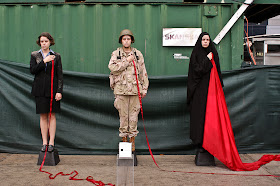 |
| At left, Granny Panties for My Ex-Girlfriend by Benjamin Entner; at right Self Portrait by Spring Hofeldt |
The downside of this approach is that regular viewers of local galleries and museums will encounter things in these shows that they've already seen before, sometimes quite recently. But those are not the viewers the Airport Gallery targets; rather, Bates creates for an audience of travelers, many of whom are not from around here and will never venture beyond the terminal as they seek ways to kill time between flights.
And, in more than 10 years of honing that aim, Bates has adopted a formula that really works - even achieving national recognition for excellence in cultural programming at airports. So, it's no surprise that the new show at the Airport Gallery, titled LOL, is fresh, funny and - yes - surprising, despite including some familiar work.
 |
| OMG by Brian Kane |
Other work had a more sardonic appeal, such as Roger Bisbing's meticulously detailed, miniature construction titled Shaker Air, in which stoic wooden furnishings are arranged in the configuration of a 737 jet. Created specifically for LOL, this work's humor depends on your understanding of Shaker life, and the fact that the airport is on Shaker land.
Also thoughtful and evocative is Michael Oatman's installation titled Cesare Lombroso's House of Pizza, in which a slightly tongue-in-cheek narrative explores the unlamented stereotyping of the mustachioed Italian pizza man. Sixteen silkscreened variations of the character are arranged in a grid to illustrate the cultural phenomenon, but it's hard to get to exercised about a happy pizza guy when, well, happy pizza guys are such a good thing.
 |
| This is how you repay me? by Gregor Wynnyczuk |
Also notable for dry wit and impeccable technique are the drawings of Andrew DeGraff, an illustrator who likes to tilt at iconic figures, and who makes you smile but also makes you think. His We are All Descended from Homeless People is, rightly, the poster image for the show; and his The Lord's Typewriter and The Selection of Darwin are wonderful comments on scientific and religious objects of worship, which also happen to be beautifully crafted works of art.
Equally beautiful are the three small paintings in the show by Spring Hofeldt, which are more playful than funny, but which are so well painted they make you want to see many more. Her self-portrait distorted by a glass vessel in front of her face shows that not all postmodern feminist artists take themselves too seriously.
Two of the other three women in the show cover domestic topics (Minna Resnick on the family vacation; Joy Taylor on garden tools and personal accessories) in fun or self-mocking ways, but don't completely avoid the heaviness that seems to curse so many women artists since the awakenings of the '60s, and which doesn't plague the men quite so much, leaving them free to go completely off the wall.
Technically far more crude than Hofeldt or DeGraff, but just as clever, are the found-art musings of Gregor Wynnyczuk, who elevates kitschy paintings to the level of existentialist philosophy by placing black vinyl text on top of them, then adding evocative titles, such as What's gotten into you lately? and I'm not like the others. But his indirect take on personal issues is dwarfed by Benjamin Entner's 7-foot-long Granny Panties for My Ex-Girlfriend, which just dives right into the outrageous way relationships make us feel.
The other artists in LOL are Torrance Fish, Linda B. Horn, Steven Rolf Kroeger, and Owen Sherwood. The exhibition, which is accessible to the non-flying public from 7 a.m. to 11 p.m. every day, will remain on view through Mar. 25, 2012.
Rating: Highly Recommended
 |
| Forest Freshner by Brian Kane and Michael Oatman |











